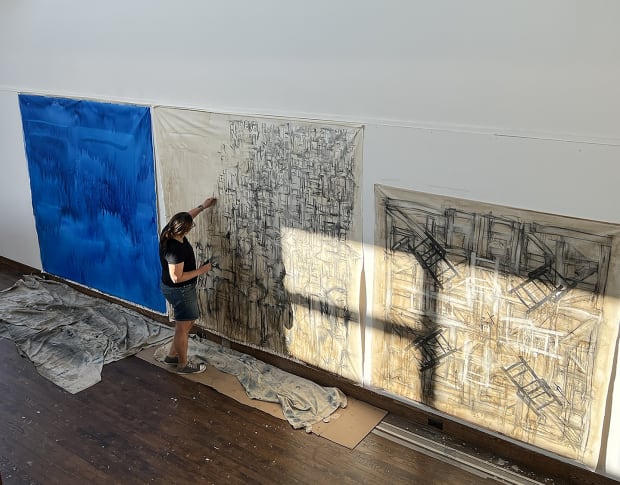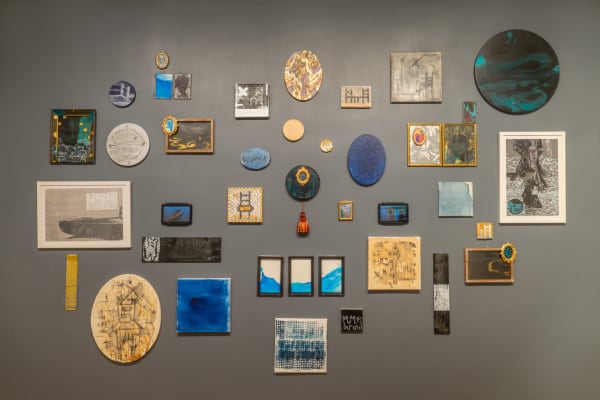-
Unquiet Objects: Works by iliana emilia García and Scherezade García
Marisa LererThe movement of people has continuously shaped cultures across the globe. Landed explores this convergence and confluence of peoples, interactions, ideas, and the materiality of memory through the introspective lenses of iliana emilia García and Scherezade García’s collages, prints, drawings, sculptures, and installation. These pensive artists are sisters who engage intimate shared family histories and both the symbolic and use value of quotidian objects. Their unquiet objects experienced here—including chairs, boats, and life preserver rings—speak to us about the repeated imagery and experience of traveling, leaving home, and creating roots in familiar and new spaces.
iliana emilia and Scherezade approach overlapping issues, address similar problems, and ponder the same questions in their work such as: What are the borders that need to be physically and metaphorically crossed? How does history shape our daily movement and interactions? How do we flow and where do we sit? Despite these shared interrogations, they create deeply distinct aesthetic solutions to these inquiries. iliana emilia sometimes engages frenetic, rigorous lines and often maintains a grounded geometric, repetitious and tonal quality to her work. In turn, Scherezade’s imagery embraces swirling and undulating compositions complemented by a vivid and vivacious color palette. Her watchful figures are sometimes depicted amidst rolling waves.
The García siblings began life playing together as children. They both pursued studies at Altos de Chavón, School of Design in the Dominican Republic and then at Parsons, The New School. Scherezade went onto an MFA at City College CUNY and iliana emilia earned an MA focused in biography at the CUNY Graduate Center. Recently, for the first time, they began working together in the same Brooklyn studio in Sunset Park. This shared space led them to initiate their collaborative artwork, which invites viewers into the intimacy of a family room and an enveloping imaginary of home. Their collective installation echoes a beloved space of their youth where odd and irregularly sized photographs once greeted visitors and their family with shared histories. iliana emilia’s and Scherezade’s place-based practices are rooted in memory and storytelling. In this current exhibition, viewers can experience works from various periods of their careers that engage ideas of passages and crossings. Their most recent works prompt a sense of moving beyond the journey to a feeling of arrival and of return.
-
Artist Biographies
iliana emilia García
Born in Santo Domingo, Dominican Republic, 1970
iliana emilia García is a drawer, painter, printmaker, and installation artist who works in large format drawings on canvas and paper and escalating installations depicting her most iconic symbol: the chair. Her work often explores concepts of emotional history, collective and ancestral memory, and intimacy.
A co-founder of the Dominican York Proyecto GRÁFICA, she holds an AAS from Altos de Chavón School of Design, a BFA from Parsons School of Design | The New School, and an MA in Biography and Memoir from The Graduate Center, CUNY.
Her work has been written about in numerous art publications and catalogues. García has been featured in solo and duo exhibitions at the Art Museum of the Americas, Taller Boricua, Hostos Community College, New York, and exhibited at BRIC, Brooklyn, NY; Exit Art, NY; No Longer Empty at Sugar Hill, NY; Smithsonian American Art Museum, Washington, DC; El Museo del Barrio, NY; Aljira Center of Contemporary Art, Newark, NJ; Leonora Vega Gallery, NY; Howard Scott Gallery, NY; NOMAA, NY; Joan Guaita, Spain; the 3rd Triennial Poli-Grafica, San Juan, Puerto Rico; Barnard College, NY; Museo de Arte Moderno de El Salvador and many other venues. Her work is included in the permanent collections of the Smithsonian American Art Museum, El Museo del Barrio, The Metropolitan Museum of Art, The Blanton Museum of Art, Texas, Museo Bellapart, El Museo de Arte Moderno in Santo Domingo, and others.She has also had a long career in fashion graphics, creating art for companies such as Guess Jeans, Gap, Rocawear, Calvin Klein Jeans, Nautica, Tommy Hilfiger, and others. An edited monograph on her work iliana emilia Garcia: the reason/ the word / the object, was published in 2020 by the Art Museum of the Americas, and edited by Olga U.Herrera, PhD. Furthermore, her artist's papers can be found at the Archives of American Art, Smithsonian Institution. She currently lives and works in Brooklyn, NY.
Scherezade García is a Dominican-born New York artist who currently lives and works between Brooklyn, New York, and Austin, Texas. García is a co-founder of the Dominican York Proyecto GRÁFICA, and she holds an AAS from Altos De Chavón School of Design as well as a BFA from Parsons School of Design | The New School and an MFA from The City College of New York, CUNY. She is also the recipient of the Colene Brown Art Prize (2020) and the Joan Mitchell Foundation Painters & Sculptors Grant (2015). Scherezade sits on the Board of Directors of the College Art Association (2020-2024) as well as being a member of the Artist Advisory Council of Arts Connection and No Longer Empty.
Her practices include painting, printmaking, and installation art, where she explores cultural colonization, politics, allegories of history, collective and ancestral memory and migration. García is the storyteller for her visual works, as she creates narratives alluding to the emotional physicality of art making. For García, she feels, “There is an urgency of a concept to keep alive." "The physical and emotional experience of drawing is essential” to García’s art making.
-
Influences
iliana emilia García’s work focuses on the “poetic and emotional examination of the history of objects.” Through this, she focuses on the value assigned to objects, such as those that we own, those that come from our homes, and those that follow us through life. Certain objects, such as the chair, are seen as a recurring object which holds memories and signifies resilience. In her work, García visually documents objects that “trigger or build up memory.” Her work aims to link "objects, places, and emotions to convert [the objects themselves] into storytellers in their own right.” For García, the chair represents tradition and visual history; the heart represents a public symbol of intimacy within communal activities. Each of these symbols represent remembrance and can be interpreted as an icon through which history can be told. The objects also represent emotional comfort and demonstrate García’s constant search for satisfaction in tradition.
Scherezade García is endlessly inspired by her fascination with the social human experience since the “discovery” of America and its multifarious results. This idea is an essential part of García’s discourse and has led to themes in her art such as the mestizo and barroquism as consequences of colonization, the consequences and causes of migration, the questioning or religious and social uses of the notion of paradise and the inversion of traditional beliefs of salvation. García uses and transformed symbols and objects that include life jackets, suitcases, inner tubes, tents, religious icons, and newspaper clippings, to create allegorical narratives.
-
 iliana emilia García in her Brooklyn studio
iliana emilia García in her Brooklyn studio -
 Scherezade García in her Brooklyn studio
Scherezade García in her Brooklyn studio -
iliana emilia García and Scherezade García: Landed | La Salita, 2025
 La Salita, 2025
La Salita, 2025La salita (2025)—the centerpiece of Landed—is the first artwork that the Dominican- born, New York-based sisters have produced together. The installation comprises forty-two intimately scaled works created individually by iliana emilia and Scherezade: paintings, prints, mosaics, and videos, which bear the characteristic symbols and concerns of their respective artistic practices. Displayed together in a salon-style hang, these works evoke a carefully considered domestic space, adorned with cherished images and objects that narrate multigenerational histories.
Indeed, La salita reimagines a room of profoundly personal and creative significance from the García sisters’ childhood in the Dominican Republic. Located within a home shared by their grandmother and great aunt, “la salita” contained their great aunt’s extensive pencil sharpener collection along with a few pieces of art. Inside this familial refuge, the sisters and their cousins were free to create and experiment; they produced plays, painted, and danced. According to Scherezade, “la salita” was “kind of magical. In a way, it had the spirit of a studio.”
Decades later, the García sisters actually share a studio, creating artworks on opposing walls in a large, light-filled space located in Brooklyn. And while their artistic practices employ distinct symbolic vocabularies, palettes, and mediums, their commonalities are rich and binding. Beyond their shared transnational and multicultural experiences, they are both preoccupied with the way in which personal storytelling, memory, and traditionalist history can coalesce to influence the future; they share an interest in seemingly mundane objects—wooden boats, chairs, picture frames, and inner tubes—which, interpreted through their artistic lenses, transform into icons; and both artists explore the ocean’s power, as a body of water that connects humanity, and as an immovable obstacle to be traversed bravely and with deference.
La salita deftly blends the themes and icons that the García sisters have developed throughout their careers. Here, iliana emilia’s figurative and material allusions to home, memory, and human exchange enter into dialogue with Scherezade’s inclusive neo-baroque narratives, her characteristic “cinnamon figure” and churning Atlantic waters. The result is an incredibly rich visual testimony in which land and sea—infused with longing and layered with multicultural encounters—converge. Bold, meticulous, and profound, La salita eloquently addresses the continuous movement of humanity while remaining rooted in a sense of place and belonging.
-
La salita Map Labels
1. Wooden frame, acrylic, charcoal, and ink on paper, SG 2. Silkscreen on wood panel, IEG
3. Wooden golden frame, and silkscreen on paper, SG
4. Metal frame with glass, and watercolor on paper, SG
5. Metal frame with glass archival inkjet print, and charcoalon canvas, SG
6. Silkscreen on canvas, IEG
7. Acrylic on oval canvas, SG
8. Mosaic on wood panel, IEG
9. Coffee, ink, and charcoal on canvas, IEG
10. Acrylic, and ink on round canvas, SG
11. Acrylic, and ink on canvas, IEG
12. Golden plaster oval frame, and silkscreen on paper, SG 13. Rectangular wooden frame, acrylic, and charcoal on ___paper, SG
14. Coffee on round canvas, IEG
15. Clear resin, and ink on paper, IEG
16. Acrylic, indigo dye, and charcoal on oval canvas, IEG
17. Golden metal frame, and silkscreen on paper with mini ___wooden golden frame and acrylic on paper, SG
18. Golden metal frame with acrylic, charcoal, and ink on ___paper, SG
19. Metal frame with acrylic on paper, SG
20. Photo lithograph, silkscreen, and chine-collé on paintedpaper, SG
21. Acrylic, and silkscreen on paper, IEG
22. Glass mosaic on wood panel, IEG
23. Indigo dye, ink, and charcoal on oval canvas, IEG
24. Acrylic, ink on round canvas and tassel. Golden mini ___frame with acrylic on paper, SG
25. Wooden golden frame with archival inkjet print on silkfabric, SG
26. Watered indigo dye on canvas, IEG
27. Metal frame and glass with silkscreen on paintedpaper, SG
28. Linocut print, and silkscreen on canvas, IEG
29. Acrylic, indigo dye, and charcoal on canvas, IEG
30. Wooden frame with watercolor on paper, SG
31. Wooden frame with watercolor on paper, SG
32. Wooden frame with watercolor on paper, SG
33. Coffee, ink, and charcoal on canvas, IEG
34. Linocut print, and silkscreen on canvas, IEG
35. Glass mosaic on wood panel, IEG
36. Rectangular wooden frame with acrylic, and charcoal ___on paper, SG
37. Golden plaster oval frame with acrylic on paper, SG 38. Coffee, ink, and charcoal on canvas, IEG
39. Silkscreen on canvas, IEG
40. Acrylic and oil crayon on canvas, IEG
V1. Video, IEG
V2. Animated video, SG -
Artist Monographs
-
-
-
-
-
-
-
-
iliana emilia García and Scherezade García: Landed
Current viewing_room











